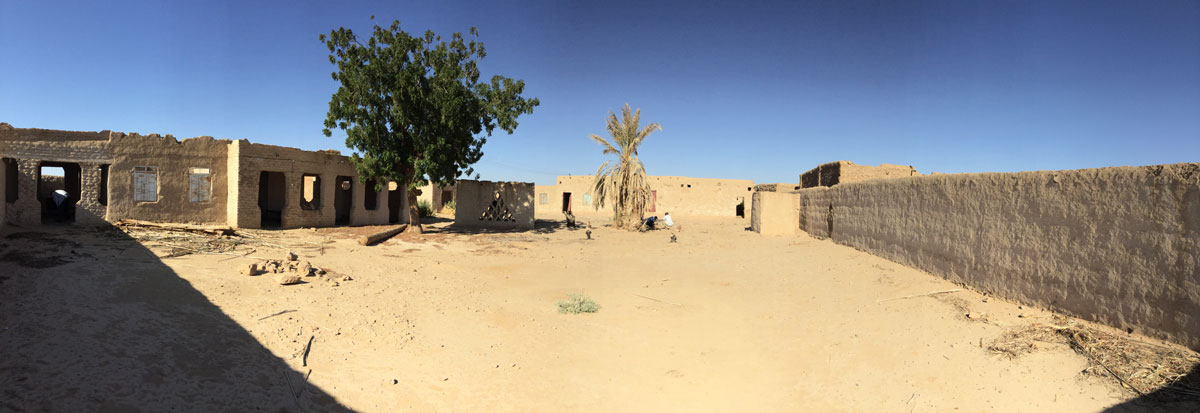
Panoramic view of the area of the temple that is incorporated in the enclosure wall of a modern house
Back to Upper Nubia: Sapienza and the Temple at Hugair Gubli
A survey conducted in January 2020 in the area of the fourth cataract, in collaboration with the Sudanese National Corporation of Antiquities and Museums (NCAM), was aimed at identifying a potential site for a new archaeological project. The mission was set within the framework of a renewed programme of fieldwork promoted by the Chair of Egyptology, which found, in the recovery of fieldwork in Sudan, an extraordinary opportunity to give continuity to the ‘historical’ presence of Sapienza in Nubia as much as to develop a fruitful research plan.
The site was identified in a monumental temple located in the modern hamlet of Hugair Gubli, some 40 km south of the archaeological complex of Jebel Barkal, on the right bank of the Nile. The temple, which had remained concealed for a long time within a private house of Hugair, was first discovered by The Polish Joint Archaeological Expedition to Middle Nile in the early 2000s, and then partially investigated by the Sudanese Jebel Barkal Museum Archaeological Mission, but never fully excavated.

The enclosure wall of the modern house inside which is the temple of Aktisanes

Remains of the frontal part of the temple
It stands on a rocky ground facing the river and consists of a large building of which the massive foundations were cut into the local bedrock of sandstone. Its exact dimensions and layout, however, are largely unknown as only a few elements on the surface have been recorded. Among these, some huge blocks belonging to the naos and columns bases (one having the diameter of 180 cm), still in situ, give us a partial, though impressive, idea of the original magnitude of this structure.

The foundation of a column basis of Hugair Gubli temple
The identity of the cult and the chronology of the temple also need to be clarified with precision. Some decorated blocks inscribed with the name of the Kushite king Aktisanes (Gatisen; ca 300 BCE), a figure well-known from Nubian and classical sources (he is mentioned by Hecataeus of Abdera), and from his pyramid in the royal necropolis at Jebel Barkal (Bar. 11), attest a Napatan phase of the sanctuary, though a possible earlier core cannot be excluded. In this regard, the most apparent and intriguing aspect is represented by the fact that the area where the temple stands appears to have been used as a quarry (still visible behind the temple itself) and then rearranged to accommodate the religious building. Both the quarrying techniques and the tool-marks suggest a rough dating to the Kushite period, but an earlier New Kingdom exploitation of the area is very likely.

Fragmentary block with the cartouche of the Kushite king Aktisanes
The particular location of the edifice and its possible identification as a rock-cut temple (hemispeos) raise some important questions about its architecture, religious character, and chronological development, which future excavation will address in full.
Finally, the local geographical environment and landscape should be taken into consideration when establishing the context of his hitherto unknown temple. The site lies within a region that is known for having been of strategic economic importance in Late Antiquity, as the nearby fortress of Bakhit indicates. The whole area shows clear evidence of Christian and pre- and proto-Islamic occupation, including the remains (columns, shafts and capitals) of a stone church situated among the fields in the neighbouring district of Magal (the site was also visited during the Sapienza survey).

A capital from the church of Magal
A regional, local-scale approach to the temple site of Hugair Gubli, one that combines a focused excavation of the sanctuary with a detailed topographic survey of its surroundings and a keen investigation of later transformations and reuse of the space, is thus expected to impact positively on a more comprehensive understanding and diachronic reconstruction of the temple with(in) its changing cultural landscape.